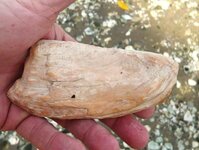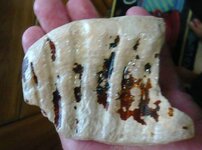BeachComber7
Sr. Member
- May 12, 2012
- 461
- 66
- Detector(s) used
- Bounty Hunter Pioneer and Tesoro deLeon
- Primary Interest:
- All Treasure Hunting
I could not resist taking a peek at the river. Was passing by it and had no intention of stopping, but I just had to see what the area looked like after TS Issac roared through soaking us for two days. Did not have a lot of time so I just browsed a little. There was not as much erosion as I expected, but plenty of shells and other things on the bank. I did not have time to comb through it all but did find a couple of things during my hurried walk. There seemed to be a lot shoved up on the river bank.
One picture is a celt, it is 4 3/4 inches long and 2 inches at its widest part. It is a nice little piece but it dries nearly white so all the lines and color is gone.
The picture with the ribbing, I have seen it on here before but I do not know if it is a celt
or what. Anyone?
One picture is a celt, it is 4 3/4 inches long and 2 inches at its widest part. It is a nice little piece but it dries nearly white so all the lines and color is gone.
The picture with the ribbing, I have seen it on here before but I do not know if it is a celt
or what. Anyone?
Attachments
Last edited:
Upvote
0


















